Making clarified butter is a relatively simple process. But, if you haven’t ever worked with clarified butter, you might be wondering what it is…and why bother going through any trouble at all, when you have been content with working with standard butter?
Both good questions…
What is Clarified Butter?
Clarified butter is butter that has been through a process to remove the water and milk solids in butter. It’s also known as Ghee. The process involves a slow heating step to melt the butter, which leads to layers. Those layers are:
- Top layer- white foamy whey;
- Middle layer – pure butterfat (the goal to save);
- Bottom layer – milk solids.
This process makes it easy to separate what you want to keep from what needs to be disposed of in getting clarified butter. After the dairy is removed, the butter is left with a nuttier flavor, a much higher smoke point, and a longer shelf life.
The Benefits of Clarified Butter
As mentioned above, clarified butter has a higher smoke point, making it better than standard butter for high-heat cooking, such as frying. By removing the dairy products and water from the original state, the butter becomes purer and will not burn like it would with milk solids in it.
Also, with the water removed, there should be less spattering when it reaches its boiling point.
And lastly, you could extend its shelf life by purifying it. I will get into that further down in the article when I discuss storage options.
Related: How To Make Potato Flakes With 5 Years Shelf Life (without refrigeration)
The Supplies Needed
There aren’t too many supplies needed to achieve clarified butter, and most are probably already in your home.
- Butter;
- Plastic storage bag (I used a Ziploc gallon-sized bag);
- Pot;
- Container for storage.
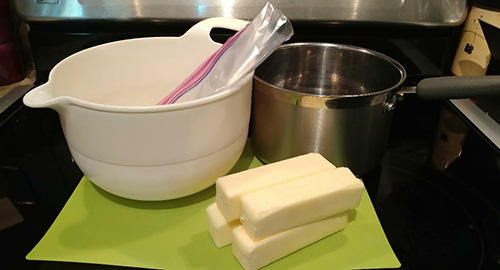 There isn’t a specific amount of butter for this process, because it all depends on how much you want to make. And, it could be salted or unsalted. However, just keep in mind that if you are going to use it for baking, you need to factor in the amount of salt if you use salt.
There isn’t a specific amount of butter for this process, because it all depends on how much you want to make. And, it could be salted or unsalted. However, just keep in mind that if you are going to use it for baking, you need to factor in the amount of salt if you use salt.
Just a quick word about using a plastic baggie, for those who might be concerned about boiling foods in plastic. This process never reaches the boiling point. It’s a very low and slow melt, and I held the bag the entire time (about 15 minutes) so it wouldn’t touch the sides or bottom.
Related: My First Batch Of Canned Cheese
How to Make It
Making clarified butter is far less intimidating than it sounds. It’s fairly easy if you follow the instructions below:
#1. Put the butter into the plastic bag, then seal.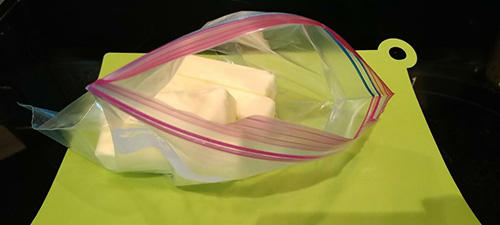 #2. Place the bag into a pot of simmering water (try to avoid the bag from touching the bottom of the hot pot).
#2. Place the bag into a pot of simmering water (try to avoid the bag from touching the bottom of the hot pot).
#3. As it melts, you will notice it starting to separate.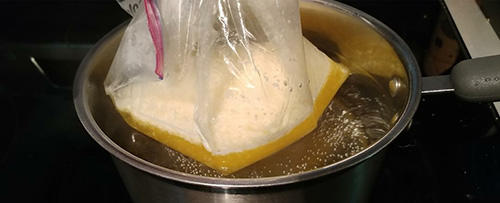 #4. After the butter is melted, place the bag in a bowl, then put it in the refrigerator. Position the bag so that one corner is at the bottom of the bowl. You can do this by placing ice and/or paper towels around the bottom so it doesn’t move.
#4. After the butter is melted, place the bag in a bowl, then put it in the refrigerator. Position the bag so that one corner is at the bottom of the bowl. You can do this by placing ice and/or paper towels around the bottom so it doesn’t move.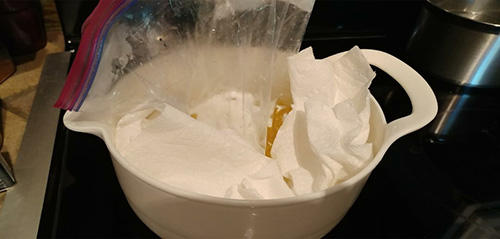 #5. Once it’s solidified, hold the bag over a bowl, then cut the tip of that corner you carefully placed earlier, so that the water and milk products can easily drain out.
#5. Once it’s solidified, hold the bag over a bowl, then cut the tip of that corner you carefully placed earlier, so that the water and milk products can easily drain out.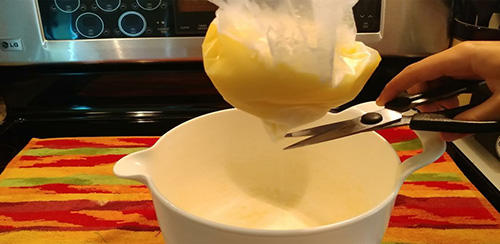 #6. Lightly rinse the solidified block of clarified butter with cool water for a few seconds. Pat it dry.
#6. Lightly rinse the solidified block of clarified butter with cool water for a few seconds. Pat it dry.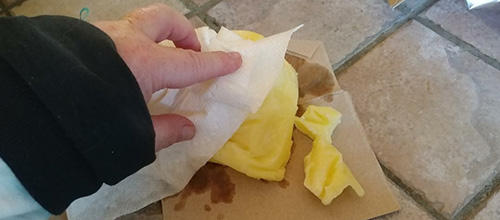 You now have clarified butter that you can cut into whatever size pieces you prefer.
You now have clarified butter that you can cut into whatever size pieces you prefer.
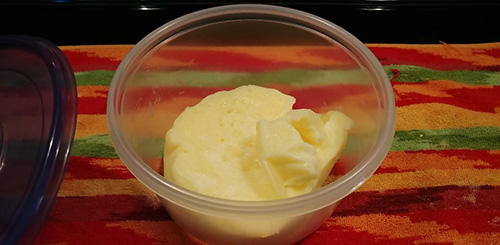
How to Store It
Place the clarified butter into an air-tight container. Like that your Ghee can be stored for up to one whole year and even beyond if there is no change in taste and appearance. Keep in mind that while it doesn’t need to be refrigerated it does need to be placed in a dark and slightly cooler place than your kitchen. A root cellar or basement pantry will do just fine. Once the container is open it will keep good for about 3 months at room temperature.
You may also like:
 How To Make Dandelion Honey Butter
How To Make Dandelion Honey Butter
This Strange Method Will Make Your Food Last For 2 Years Without Refrigeration (Video)
What Foods Can You Bury Underground For Winter?

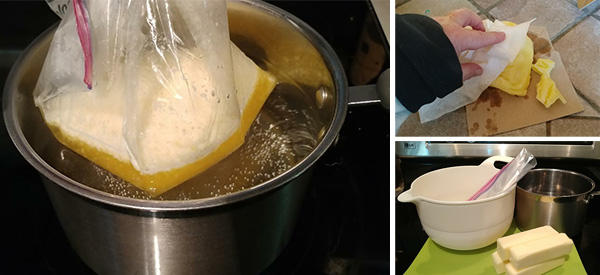













I make clarified butter for cooking and for eating seafood. This process looks like the easiest way to do it. I can’t wait to try it.
you can also make butter from canned Media Crema from your long term storage.
For those of you, like me, who don’t have a clue what Media Crema, is, it is canned half and half and comes in a 7.6 ounce can. Apparently Nestles has the market cornered because that’s the only brand I saw.
When I went on line searching for Media Crema, I saw a website with a video of how to make butter from M.C. You apparently can also make sour cream and a couple other products. I didn’t do an extensive search.
Of course, if your local grocery doesn’t carry M.C., our good friends at Amazon will be happy to fill that deficit for you. Here in SoCal and any area with a large Latino population should have local stores that carry it.
Trader Joe carries ghee. It comes in an 8 ounce jar and is about 53¢ an ounce in the TJ where I shop. The reviews of TJ’s ghee on Amazon panned it saying that it had too many milk solids left in it. I didn’t buy it to try it. I am not a ghee expert, so can’t pass an opinion at all on the quality of TJ’s ghee. It definitely is cheaper to buy the ghee in the store than on line from Amazon. It is $1.06 an ounce or twice as much from Amazon as the in-store ghee.
I learned about Ghee from Graham Kerr, the Galloping Gourmet of PBS fame. He called it simply :”clarified butter”, which as a Teen I then made it every time I had popcorn. What a great flavor. As an adult, I’ve broadened its use to include seafood, and I’ll even drop some drips on a grilled steak. Mmmm-mmm! Corn on the Cob, too. Grits? Whew.
I think people worry about butter going bad needlessly. When the Brits owned Hong Kong and before air delivery was so cheap, butter was shipped from England to Hong Kong via ship. Even coming through the canal, that was a long voyage. In the days before the Suez Canal, it was shipped around the Horn. That was even a longer voyage.
Those days were before mechanical refrigeration. It’s my understanding butter was packed in sawdust and placed deep in the hold of the ship where, perhaps, the cool water kept the hold somewhat cooler than the weather decks. That might have worked in the days of sailing vessels, but with machinery running and not much air circulating, the holds on steamers must have been warm. Remember, the furnaces and boilers were below decks. I can personally attest that holds on board a troop ship were very warm, even when the weather topside was very cold.
While I realize in some areas of the country 98°F is just getting warmed up, it was 98 on my patio today and only 81 in Bakersfield. My butter still sat out on the counter where it always sits. Maybe I don’t know rancid butter from Shinola, but my butter sits out day and night no matter what the temperature. I don’t have a/c. Most of the time no need for it. Today is a huge anomaly. Nobody in this town has ever said, “let’s go to Bakersfield to cool off.”
Ghee certainly has some advantages and I would think if you keep it at an even temperature, cool, dark area, it would last longer than a year. To the best of my knowledge, I have never smelled rancid butter, but I suspect I would know it immediately upon opening the package. I think it is much like comfit, kept reasonably cool in a dark place it lasts indefinitely.
Just my opinion. By the way, most article I have read about butter state that it is perfectly safe on your counter top and doesn’t need to be refrigerated.
The salt in butter is a preservative. I don’t think I would want unsalted butter to stay in a warm environment for very long.
Could be. I think I read some place that salted butter lasts longer than unsalted but that is the extent of my knowledge on that. I think the longest a quarter pound of butter has sat on my kitchen counter in blazing hot weather (for us that is in the 90s) is about a week. If it turned rancid, I was too dumb to realize it. Obviously it didn’t kill me or as far as I know, even make me sick.
Chuck, if you smelled rancid butter you would definitely know about it. You also definitely wouldn’t have eaten it. People do worry too much about it though. I keep my butter dish on the counter year round and it’s never gone rancid. I think you’d have to get very careless and be using unsalted butter to have any problems. Of course the same butter isn’t sitting out for more than a week.
Claude: That’s what I figured. In most cases, food that has gone “bad” doesn’t leave any doubt in anyone’s mind that it is not fit to eat. I guess that is nature’s way of saying, “Whoa! Back off. This stuff will really make you sick.”
Now I did take a mouthful of cashews that had gone rancid. There was no warning odor, but as soon as I bit into them I knew. No doubt whatsoever. Same with some rancid peanuts. I have a habit of keeping nuts around too long. If there is an odor to rancid peanuts and cashews, it is a mild odor. I didn’t detect it upon opening the jar, only when I bit into the nuts. You might take a mouthful of rancid nuts but you won’t swallow them even if you are really, really hungry.
My mother, grandmother, and granbue always kept butter on the counter, near the bread box, in a covered dish. Im 63..my butter is kept the same way. Never had an issue.
As long as it’s kept covered and in a reasonably cool place, I think it will keep good without going rancid for maybe a week or more.
If the place was too hot, you’ll notice it from its appearance. The outer layer of the butter will turn translucent and its color will change, and if it really sat there too long you will notice by the smell as well.
After some more time, butter will even get moldy and this will alter its smell and taste drastically.